Spatio-Temporal Characteristics and Influencing Factors of Basic Public Service Levels in the Yangtze River Delta Region, China
Abstract
:1. Introduction
2. Materials and Methods
2.1. Study Area
2.2. Indicator System and Data Sources
2.3. Methods
2.3.1. Entropy-Weighted TOPSIS Method
- Construct the evaluation index system matrix (M).
- 2.
- The index matrix was standardized using the polar difference method.
- 3.
- Calculate the entropy value.
- 4.
- Determination of indicator weights.
- 5.
- Calculate the normalized entropy weight matrix (O).
- 6.
- Determine the positive ideal solution and the negative ideal solution.
- 7.
- Calculate the distance of each indicator to the positive ideal solution and the negative ideal solution.
- 8.
- Calculate the comprehensive evaluation index.
2.3.2. Exploratory Spatial Data Analysis
2.3.3. Geographically and Temporally Weighted Regression
3. Spatial and Temporal Evolutionary Characteristics of the BPSL
3.1. Analysis of Temporal Evolution Characteristics
3.1.1. Analysis of Overall Level Change
3.1.2. Analysis of Internal Variation Change
3.1.3. Analysis of Time-Series Evolution Laws
3.2. Analysis of Spatial Evolution Characteristics
3.2.1. Spatial Trend Analysis
3.2.2. Spatial Pattern Analysis
3.2.3. Spatial Association Analysis
4. Analysis of the Factors Influencing Spatio-Temporal Divergence
4.1. Variables and Model Selection
4.2. Analysis of GTWR Results
5. Conclusions
- (1)
- From 2010 to 2020, the BPSL in the YRDR generally improved, demonstrating a gradual upward trend. Intra-provincial and inter-provincial differences in the BPSL vary greatly, with intra-provincial differences being Jiangsu Province > Anhui Province > Zhejiang Province. The inter-provincial differences show an “M”-shaped trend with an “increasing–decreasing” pattern twice. Over time, the BPSL in the YRDR gradually shifted from unipolar polarization to multipolar differentiation and a flattening trend, with the spatial polarization effect gradually weakening, and the diffusion effect gradually increasing.
- (2)
- In terms of spatial trends, the BPSL displays a decreasing gradient from east to west with increasing geographical distance, presenting an inverted “U” shape distribution in the north–south direction. In general, the BPSL shows a spatial circle structure of high in the east and low in the west, and high in the center and low in the north and south, forming a spatial distribution pattern of high-level and higher-level grades mainly in Shanghai, southern Jiangsu, and northern Zhejiang. The BPSL shows a strong global spatial correlation, which becomes more significant over time. The four clustering patterns are distributed across the local spatial correlation, and a “spatial club convergence” phenomenon can be observed.
- (3)
- The spatial and temporal heterogeneity of the BPSL in the YRDR results from the combined effect of various influencing factors, all of which have apparent spatial and temporal heterogeneities. Among them, the UL has a noticeable positive influence on the BPSL, while the other five factors have both positive and negative influences: the EDL, the ISL, and the DEO have positive influences on the BPSL in general, and the GAC and the RPS have negative influences on the BPSL in general. It should be noted, however, that the influence of each factor varies from region to region over time.
Author Contributions
Funding
Institutional Review Board Statement
Informed Consent Statement
Data Availability Statement
Conflicts of Interest
References
- Fan, J.; Zhao, Y.N. China’s Regional Development Pattern Oriented toward Modernization: The Scientific Connotation and Strategic Priorities. Econ. Geogr. 2021, 41, 1–9. [Google Scholar]
- Chen, W.; Sun, W.; Liu, C.G.; Liu, W. Regional Integration and High-quality Development in the Yangtze River Delta Region. Econ. Geogr. 2021, 41, 127–134. [Google Scholar]
- Cao, W.D.; Zeng, G.; Zhu, S.J.; Cao, Y.X.; Sun, B.D.; Cao, B.R.; Cui, C.; Duan, X.J.; Zhang, J.X.; Sun, W.; et al. High-quality integrated development in the Yangtze River Delta region: Problems and solutions. J. Nat. Resour. 2022, 37, 1385–1402. [Google Scholar] [CrossRef]
- Chen, W.; Lan, M.H.; Sun, W.; Liu, W.; Liu, C.G. Integrated high-quality development of the Yangtze River Delta: Connotation, current situation and countermeasures. J. Nat. Resour. 2022, 37, 1403–1412. [Google Scholar] [CrossRef]
- Smith, A. An Inquiry into the Nature and Causes of the Wealth of Nations. University Of Chicago Press: Chicago, IL, USA, 1977. [Google Scholar]
- Samuelson, P.A. The pure theory of public expenditure. Rev. Econ. Stat. 1954, 36, 387–389. [Google Scholar] [CrossRef]
- Zhou, M.H.; Jia, K.J. Marxist theory of public goods and its practical significance. Probe 2009, 5, 146–151. [Google Scholar]
- Yang, J. Critical Interpretation of Western Public Goods Theory in the Marxist Perspective. Teach. Res. 2009, 8, 17–22. [Google Scholar]
- Arends, H. The dangers of fiscal decentralization and public service delivery: A review of arguments. Politische Vierteljahr. 2020, 61, 599–622. [Google Scholar] [CrossRef]
- Gibson, A.; Asthana, S. A tangled web: Complexity and inequality in the English local government finance settlement. Local Gov. Stud. 2012, 38, 301–319. [Google Scholar] [CrossRef]
- Elg, M.; Wihlborg, E.; Örnerheim, M. Public quality–for whom and how? Integrating public core values with quality management. Total Qual. Manag. Bus. Excell. 2017, 28, 379–389. [Google Scholar] [CrossRef]
- Mhlanga, D.; Garidzirai, R. The influence of racial differences in the demand for healthcare in South Africa: A case of public healthcare. Int. J. Environ. Res. Public Health 2020, 17, 5043. [Google Scholar] [CrossRef]
- Jabur, S.D.; Khalil, S.M. Spatial variation of primary education services in Iraq for the academic year 2018–2019. Basic Educ. Coll. Mag. Educ. Humanit. Sci. 2020, 48, 1261–1273. [Google Scholar]
- Macharia, P.M.; Ouma, P.O.; Gogo, E.G.; Snow, R.W.; Noor, A.M. Spatial accessibility to basic public health services in South Sudan. Geospat. Health 2017, 12, 510. [Google Scholar] [CrossRef]
- Viriyathorn, S.; Phaiyarom, M.; Rueangsom, P.; Suphanchaimat, R. Spatial Panel Data Analysis on the Relationship between Provincial Economic Status and Enrolment in the Social Security Scheme amongst Migrant Workers in Thailand, 2015–2018. Int. J. Environ. Res. Public Health 2021, 19, 181. [Google Scholar] [CrossRef]
- van den Heever, A.M. The role of insurance in the achievement of universal coverage within a developing country context: South Africa as a case study. BMC Public Health 2012, 12, S5. [Google Scholar] [CrossRef] [Green Version]
- Simson, R. Ethnic (in) equality in the public services of Kenya and Uganda. Afr. Aff. 2019, 118, 75–100. [Google Scholar] [CrossRef]
- Saidi, A.; Hamdaoui, M.; Moussa, W. Assessing policy effectiveness in reducing inequality of opportunity in access to public services and education among Tunisian children. J. Knowl. Econ. 2021, 12, 993–1018. [Google Scholar] [CrossRef]
- Vaishar, A.; Šťastná, M. Accessibility of Services in Rural Areas: Southern Moravia Case Study. Sustainability 2021, 13, 9103. [Google Scholar] [CrossRef]
- Gazzeh, K.; Abubakar, I.R. Regional disparity in access to basic public services in Saudi Arabia: A sustainability challenge. Util. Policy 2018, 52, 70–80. [Google Scholar] [CrossRef]
- Kim, S.; Vandenabeele, W.; Wright, B.E.; Andersen, L.B.; Cerase, F.P.; Christensen, R.K.; Desmarais, C.; Koumenta, M.; Leisink, P.; Liu, B.C.; et al. Investigating the structure and meaning of public service motivation across populations: Developing an international instrument and addressing issues of measurement invariance. J. Public Adm. Res. Theory 2013, 23, 79–102. [Google Scholar] [CrossRef]
- Vandenabeele, W.; Brewer, G.A.; Ritz, A. Past, present, and future of public service motivation research. Public Adm. 2014, 92, 779–789. [Google Scholar] [CrossRef]
- Perry, J.L.; Vandenabeele, W. Public service motivation research: Achievements, challenges, and future directions. Public Adm. Rev. 2015, 75, 692–699. [Google Scholar] [CrossRef]
- Van Loon, N.; Kjeldsen, A.M.; Andersen, L.B.; Vandenabeele, W.; Leisink, P. Only when the societal impact potential is high? A panel study of the relationship between public service motivation and perceived performance. Rev. Public Pers. Adm. 2018, 38, 139–166. [Google Scholar] [CrossRef] [PubMed]
- Osborne, S.P.; Radnor, Z.; Kinder, T.; Vidal, I. The SERVICE framework: A public-service-dominant approach to sustainable public services. Br. J. Manag. 2015, 26, 424–438. [Google Scholar] [CrossRef]
- Berman, E.M.; Bowman, J.S.; West, J.P.; Van Wart, M.R. Human Resource Management in Public Service: Paradoxes, Processes, and Problems; CQ Press: Washington, DC, USA, 2021. [Google Scholar]
- Shi, W.D.; Zhao, L. The Measure of the Quality of Basic Public Services in Shandong Province and Its Spatial Patterns. Econ. Geogr. 2015, 35, 32–37. [Google Scholar]
- Ma, H.Q.; Han, Z.L.; Jiang, H.X. The Characteristics and Spatial Differences of Basic Public Services of Cities at Prefecture Level and above in China. Econ. Geogr. 2011, 31, 212–217. [Google Scholar]
- Li, B.; Han, Z.L.; Ma, H.Q. Temporal and Spatial Analysis of Differences of the Quality of Basic Public Service of Cities in Liaoning Province. Hum. Geogr. 2015, 30, 111–117. [Google Scholar]
- Zhao, L.; Zhang, Y.S.; Zhang, M.; Wu, D.T. The Spatio-Temporal Evolution and Formation Mechanism of Basic Public Service Mismatch in Northeast of China. Econ. Geogr. 2015, 35, 36–44. [Google Scholar]
- Li, S.; Yang, Y.X. Equalization of Basic Public Services for Common Prosperity: Action Logic and Path Selection. China Ind. Econ. 2022, 2, 27–41. [Google Scholar]
- Han, Z.L.; Li, B.; Zhang, K.L. Evaluation and spatial analysis of the equalization of basic public service in urban and rural areas in China. Geogr. Res. 2015, 34, 2035–2048. [Google Scholar]
- Li, H.; Dong, Y.L. The Equalization Measurement and Trend Evolution of China’s Basic Public Service—A Study Based on High Quality Development. China Soft Sci. 2020, 10, 74–84. [Google Scholar]
- Yang, G.; Xue, Y.; Ma, Y. Social organization participation, government governance and the equalization of basic public services: Evidence from China. Int. J. Environ. Res. Public Health 2019, 16, 2996. [Google Scholar] [CrossRef] [PubMed] [Green Version]
- Zeng, S.; Xia, F.; Yang, P. The Equalization Gap of Basic Public Services Supply in China: An Empirical Study on Education, Health Care and Social Security. China Financ. Econ. Rev. 2018, 7, 24–51. [Google Scholar]
- Han, X. Ways to Improve the Accessibility of Rural Basic Public Services under the Background of Rural Revitalization. Int. J. Intell. Inf. Manag. Sci. 2021, 10, 132–135. [Google Scholar]
- Yin, P.; Li, C.G.; Chen, C.; Duan, P.L. Relationship between Population Urbanization and Basic Public Service in the Context of the New Urbanization—Take Jilin Province for Example. Econ. Geogr. 2015, 35, 61–67. [Google Scholar]
- Zeng, F.R.; Li, L.W.; He, Z.C.; Wang, Z.K. Research on the Dynamic Relationship between Basic Public Service Level and New -type Urbanization. China Soft Sci. 2019, 12, 150–160. [Google Scholar]
- Xu, G.Y. The Conjunction and Horizon of Common Wealth and Equalization of Basic Public Services in Urban and Rural Areas. J. Public Policy Adm. 2022, 6, 56–61. [Google Scholar]
- Li, Z.F.; Wei, F.Q. Research on Coupling and Coordinating Development of Urbanization Quality and Basic Public Services at Large Regional Scale: Take Shanxi Province as an example. Aussie-Sino Stud. 2019, 5, 71–74. [Google Scholar]
- Lin, L.Y.; Zhu, Y.; Ke, W.Q.; Wang, J.S. The impact of migrants’ access to urban public services on their urban settlement intentions: A study from the perspective of different-sized cities. Acta Geogr. Sin. 2019, 74, 737–752. [Google Scholar]
- Yang, L.; Chau, K.W.; Wang, X. Are low-end housing purchasers more willing to pay for access to basic public services? Evidence from China. Res. Transp. Econ. 2019, 76, 100734. [Google Scholar] [CrossRef]
- Fan, B.; Yang, W.; Han, T. Impact of basic public service level on pro-environmental behavior in China. Int. Sociol. 2018, 33, 738–760. [Google Scholar] [CrossRef]
- Wang, F.; Bai, Y.P.; Zhou, L.; Ji, X.P.; Xu, Z.B.; Qiao, F.W. Spatial pattern and influencing factors of the equalization of basic education public service in China. Geogr. Res. 2019, 38, 285–296. [Google Scholar]
- Wang, W.; Zhao, Z.J. Spatial decomposition of funding inequality in China’s basic education: A four-level Theil index analysis. Public Financ. Manag. 2014, 14, 416–436. [Google Scholar]
- Guo, L.; Bao, Y.; Li, S.; Ma, J.; Sun, W. Quality analysis and policy recommendations on the utilization of community basic public health services in urban and suburban Shanghai from 2009 to 2014. Environ. Sci. Pollut. Res. 2018, 25, 28206–28215. [Google Scholar] [CrossRef]
- Zhao, Y.; Cui, S.; Yang, J.; Wang, W.; Guo, A.; Liu, Y.; Liang, W. Basic public health services delivered in an urban community: A qualitative study. Public Health 2011, 125, 37–45. [Google Scholar] [CrossRef]
- Shi, T.; Zhao, E.Y.; Liu, D.X. Provincial Differences of Equalization and the Spatial Pattern of Urban Social Security in China. Popul. Econ. 2015, 2, 87–97. [Google Scholar]
- Ma, H.Q.; Wang, Q.; Gong, Z.G. The spatio-temporal evolution of basic public services equalization in Beijing–Tianjin–Hebei region. J. Arid. Land Resour. Environ. 2016, 30, 64–69. [Google Scholar]
- Zhao, L.; Zhang, Y.S.; Jiao, X.Y.; Wu, D.; Wu, D.T. The Spatial Pattern and Effect of Basic Public Service Quality in Henan Province. Sci. Geogr. Sin. 2016, 36, 1495–1504. [Google Scholar]
- Liu, X.J.; Xia, S.Y.; Li, D.; Zheng, C.R.Y.; Wei, X.C. Spatial and Temporal Differentiation and Influencing Factors of Basic Public Service Quality in Hunan Province. Resour. Environ. Yangtze Basin 2020, 29, 1535–1544. [Google Scholar]
- Cao, S.; Liu, S.Q.; Peng, L.; Xu, D.D. Spatial pattern and mechanisms of basic public services in Sichuan. J. Univ. Chin. Acad. Sci. 2017, 34, 351–361. [Google Scholar]
- Han, Z.L.; Zhu, J.; Zhong, J.Q.; Yan, X.L. Spatio-Temporal Characteristics and Evolution Mechanism for the Equalization of Basic Public Service in Island Counties of China. Econ. Geogr. 2021, 41, 11–22. [Google Scholar]
- Cui, L.; Zhou, H. Spatial feature analysis of rural basic public service supply based on TOPSIS model and Data aggregation algorithm. J. Intell. Fuzzy Syst. 2020, 39, 5623–5634. [Google Scholar] [CrossRef]
- Liu, H.L.; Hu, X.H.; Guo, Z.S.; Li, M. Spatio-temporal Evolution and Influencing Factors of the Coordinated Development of Basic Public Services and Urbanization in Zhongyuan Urban Agglomeration. J. Nat. Sci. Hunan Norm. Univ. 2021, 44, 71–80. [Google Scholar]
- Yin, P.; Wang, F.X.; Duan, P.L. Spatial-temporal Coupling Relationship Between Basic Public Service Efficiency and Urbanization Quality in China. Sci. Geogr. Sin. 2021, 41, 571–579. [Google Scholar]
- Wang, L.; Rong, X.; Mu, L. The spatial pattern and dynamic evolution of basic public service level in Beijing-Tianjin-Hebei region from the perspective of COVID-19. Eng. Constr. Archit. Manag. 2022; ahead-of-print. [Google Scholar]
- Guo, Y.; Cao, X.Z.; Wei, W.D.; Zeng, G. The impact of regional integration in the Yangtze River Delta on urban carbon emissions. Geogr. Res. 2022, 41, 181–192. [Google Scholar]
- Li, B.; Li, T.; Zhu, Y. Equalization of Public Services, Financial Expenditure on People’s Livelihood and Urbanization—An Empirical Study Based on Dynamic Spatial Econometrics Models by Use of Panel Data from 286 Cities of China. China Soft Sci. 2015, 6, 79–90. [Google Scholar]
- Liu, C.M.; Zhang, C.M.; Ren, Q.L.; Song, J.; Shen, Q. Coupling Mechanism and Spatiotemporal Evolution Between the Basic Public Services and the Economic Development: The Case of 13 Cities in Jiangsu Province. Econ. Geogr. 2019, 39, 26–33. [Google Scholar]
- Sahoo, M.M.; Patra, K.C.; Swain, J.B.; Khatua, K.K. Evaluation of water quality with application of Bayes’ rule and entropy weight method. Eur. J. Environ. Civ. Eng. 2017, 21, 730–752. [Google Scholar] [CrossRef]
- Hwang, C.L.; Yoon, K.P. Multiple Attribute Decision Making: Methods and Applications; Springer: New York, NY, USA, 1981; pp. 124–130. [Google Scholar]
- Elsayed, E.A.; Dawood, A.S.; Karthikeyan, R. Evaluating alternatives through the application of TOPSIS method with entropy weight. Int. J. Eng. Trends Technol. 2017, 46, 60–66. [Google Scholar] [CrossRef]
- Kim, A.R. A study on competitiveness analysis of ports in Korea and China by entropy weight TOPSIS. Asian J. Shipp. Logist. 2016, 32, 187–194. [Google Scholar] [CrossRef]
- Anselin, L. Spatial Econometrics: Methods and Models; Springer Science & Business Media: New York, NY, USA, 1988. [Google Scholar]
- Haining, R.; Wise, S.; Ma, J. Exploratory spatial data analysis. J. R. Stat. Soc. Ser. D (Stat.) 1998, 47, 457–469. [Google Scholar] [CrossRef]
- Brunsdon, C.; Fotheringham, A.S.; Charlton, M.E. Geographically weighted regression: A method for exploring spatial nonstationarity. Geogr. Anal. 1996, 28, 281–298. [Google Scholar] [CrossRef]
- Huang, B.; Wu, B.; Barry, M. Geographically and temporally weighted regression for modeling spatio-temporal variation in house prices. Int. J. Geogr. Inf. Sci. 2010, 24, 383–401. [Google Scholar] [CrossRef]
- Fotheringham, A.S.; Crespo, R.; Yao, J. Geographical and temporal weighted regression (GTWR). Geogr. Anal. 2015, 47, 431–452. [Google Scholar] [CrossRef]
- Garang, Z.; Wu, C.; Li, G.; Zhuo, Y.; Xu, Z. Spatio-Temporal Non-Stationarity and Its Influencing Factors of Commercial Land Price: A Case Study of Hangzhou, China. Land 2021, 10, 317. [Google Scholar] [CrossRef]
- Anselin, L. Local indicators of spatial association—LISA. Geogr. Anal. 1995, 27, 93–115. [Google Scholar] [CrossRef]
- Bai, Y.N. Research on the Measurement of Basic Public Service Efficiency and Its Influencing Factors in the Yangtze River Delta. Master’s thesis, Zhejiang Gongshang University, Hangzhou, China, 2022. [Google Scholar]
- Yuan, D.; Ou, X.J.; Tang, Z.Q. Spatial Characteristics and Driving Factors between Population Urbanization and Public Service in the Eastern Coastal Areas. Econ. Geogr. 2017, 37, 32–39. [Google Scholar]
- Peng, Y.L.; Sun, P.J.; Luo, N.; Liu, J. Spatial-temporal Characteristics and Causes of Equalization of Basic Public Services in Chengdu-Chongqing Urban Agglomeration. Areal Res. Dev. 2022, 41, 32–37. [Google Scholar]
- Chen, Y.E.; Yin, X.; Jin, R.C. Spatio-temporal Heterogeneity and Factors Influencing of China’s Rural Inclusive Finance. J. Quant. Tech. Econ. 2020, 37, 44–59. [Google Scholar]
- The Paper. With 213% Economic Growth, Hefei Is the Most Improved City in China in the Past 10 Years [EB/OL]. 4 March 2022. Available online: https://www.thepaper.cn/newsDetail_forward_16961130 (accessed on 6 July 2022).
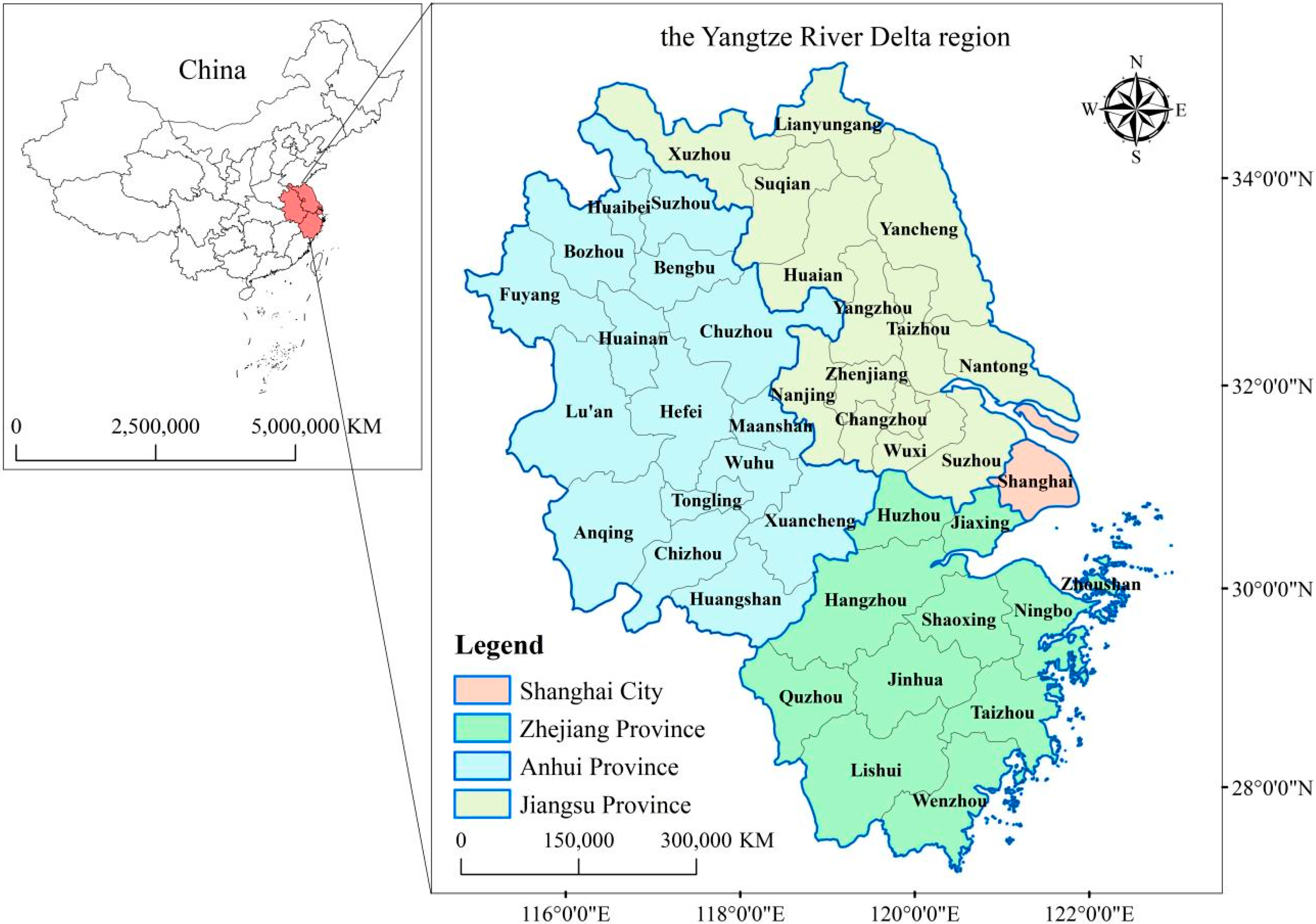

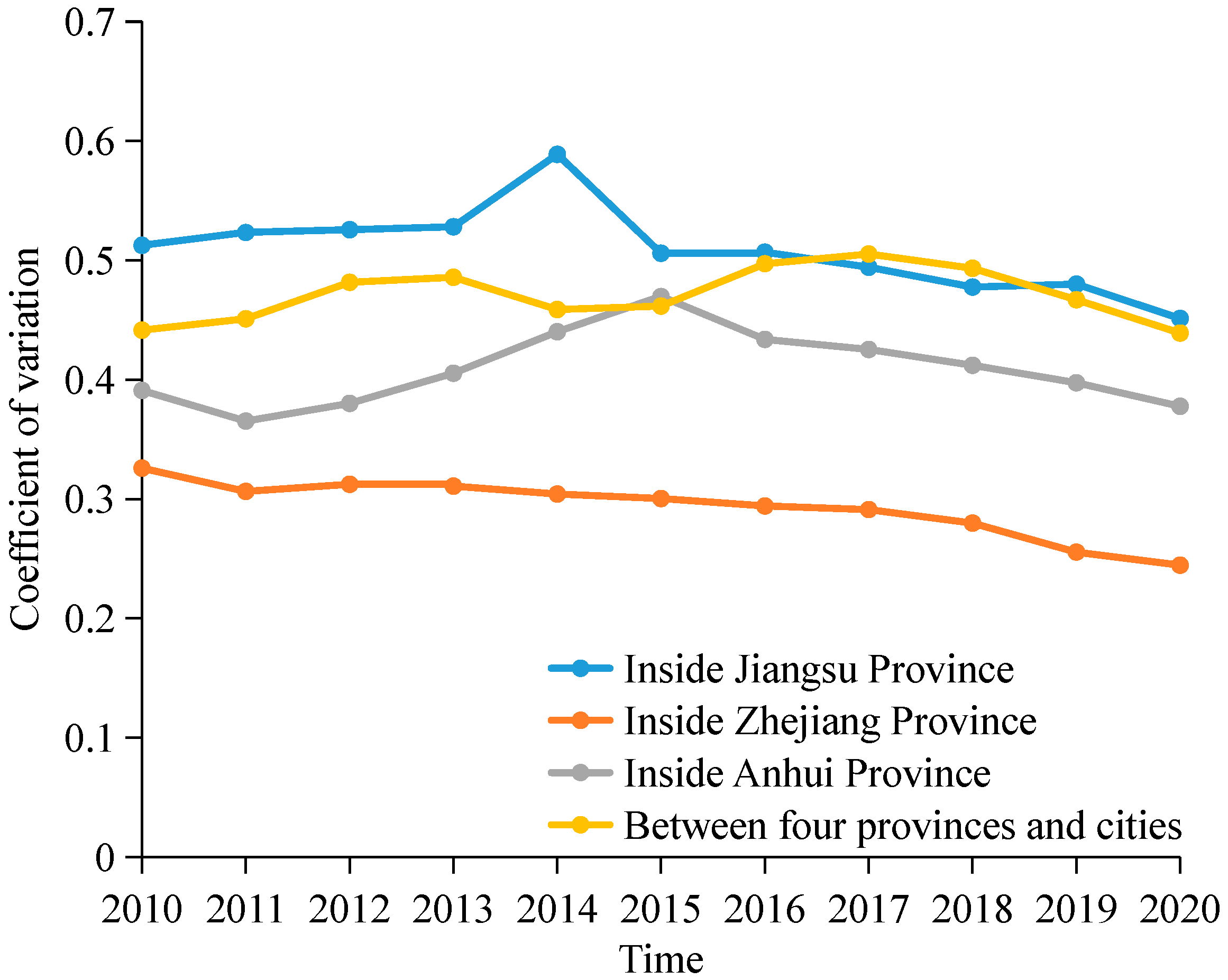
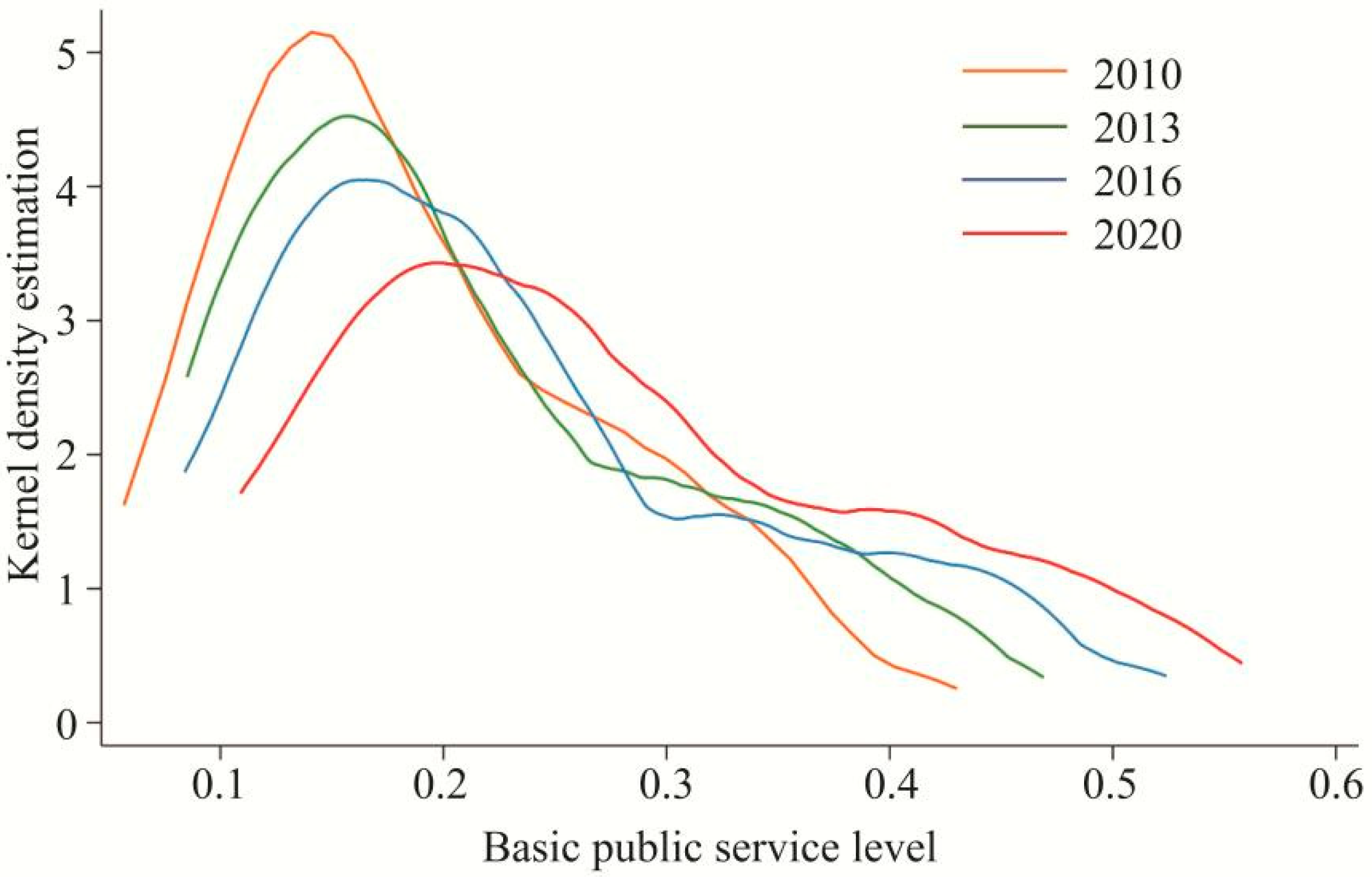
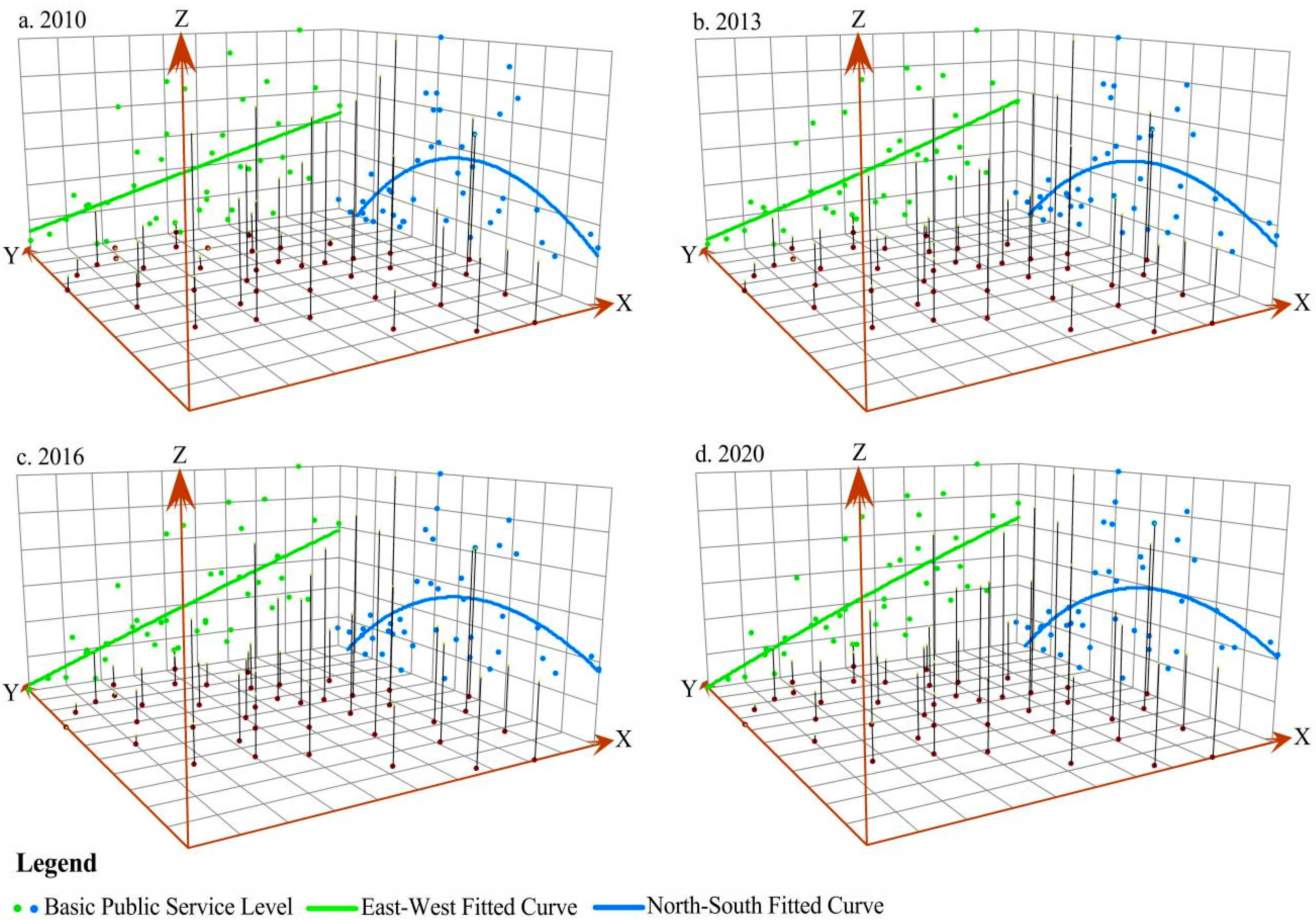
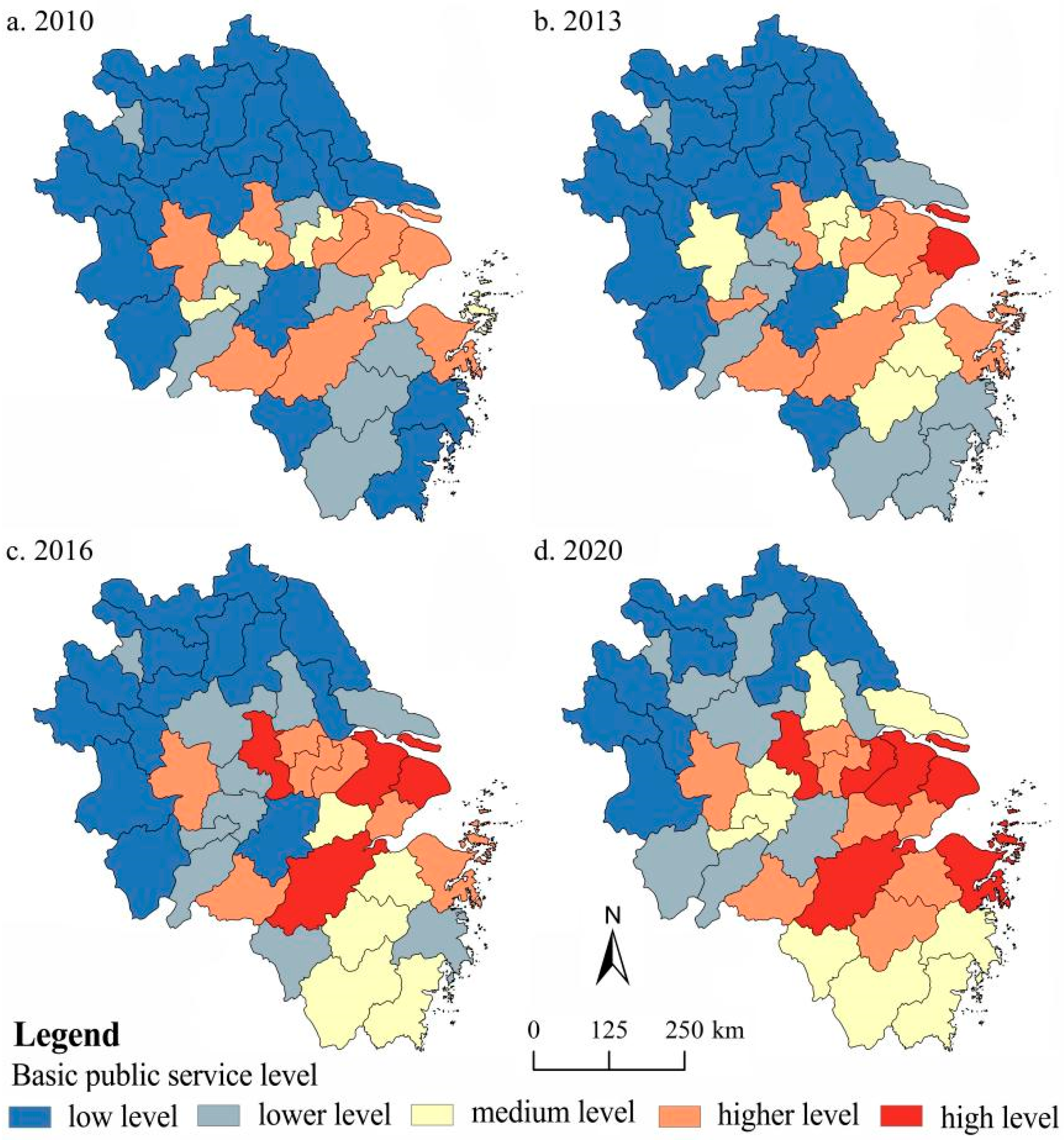
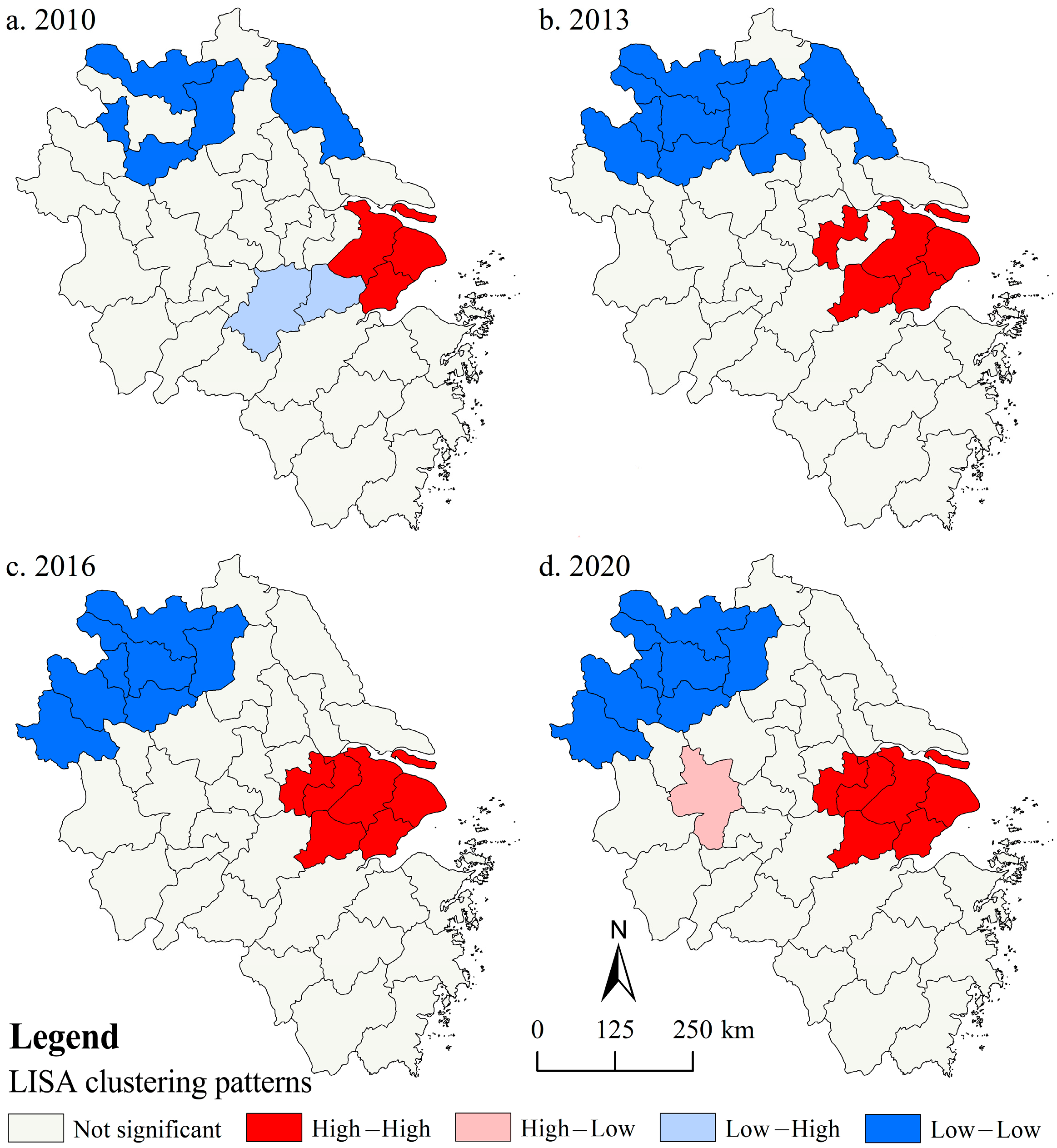
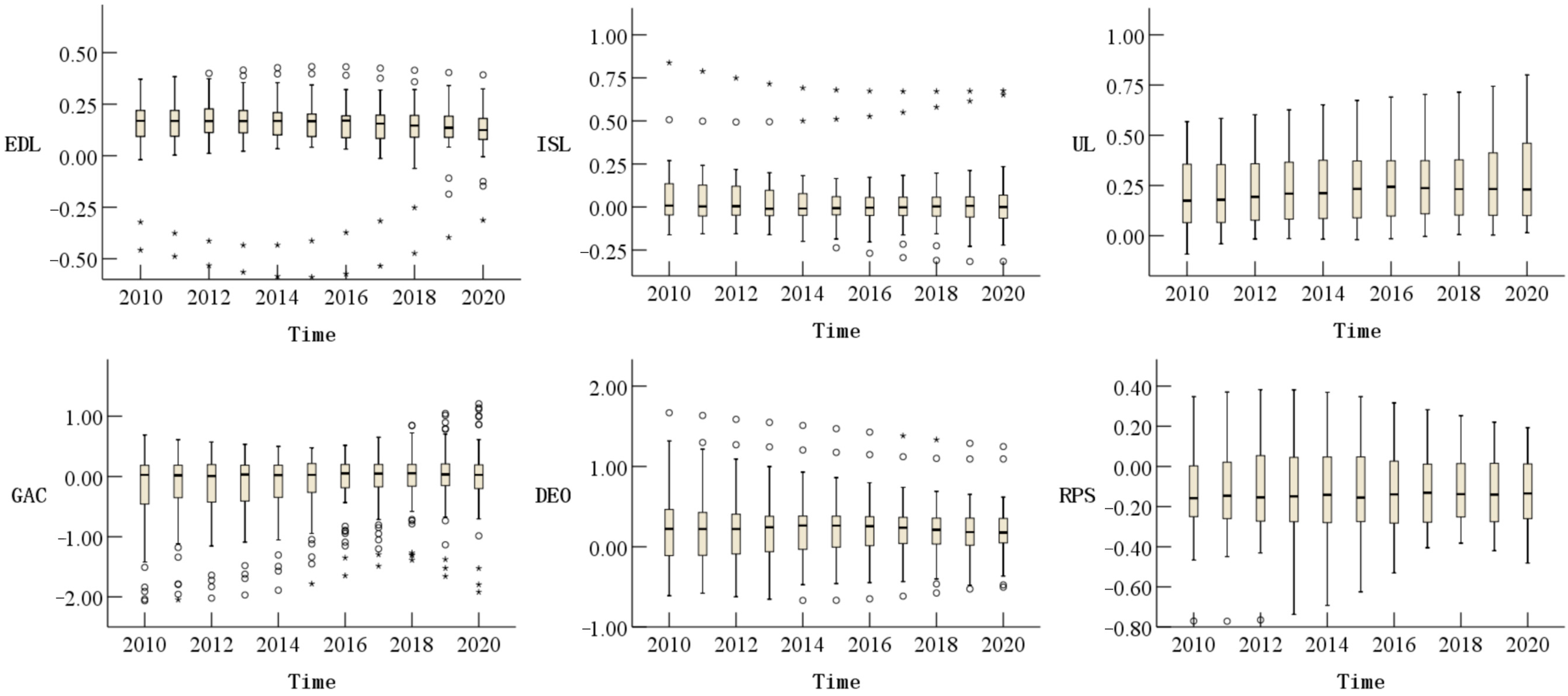
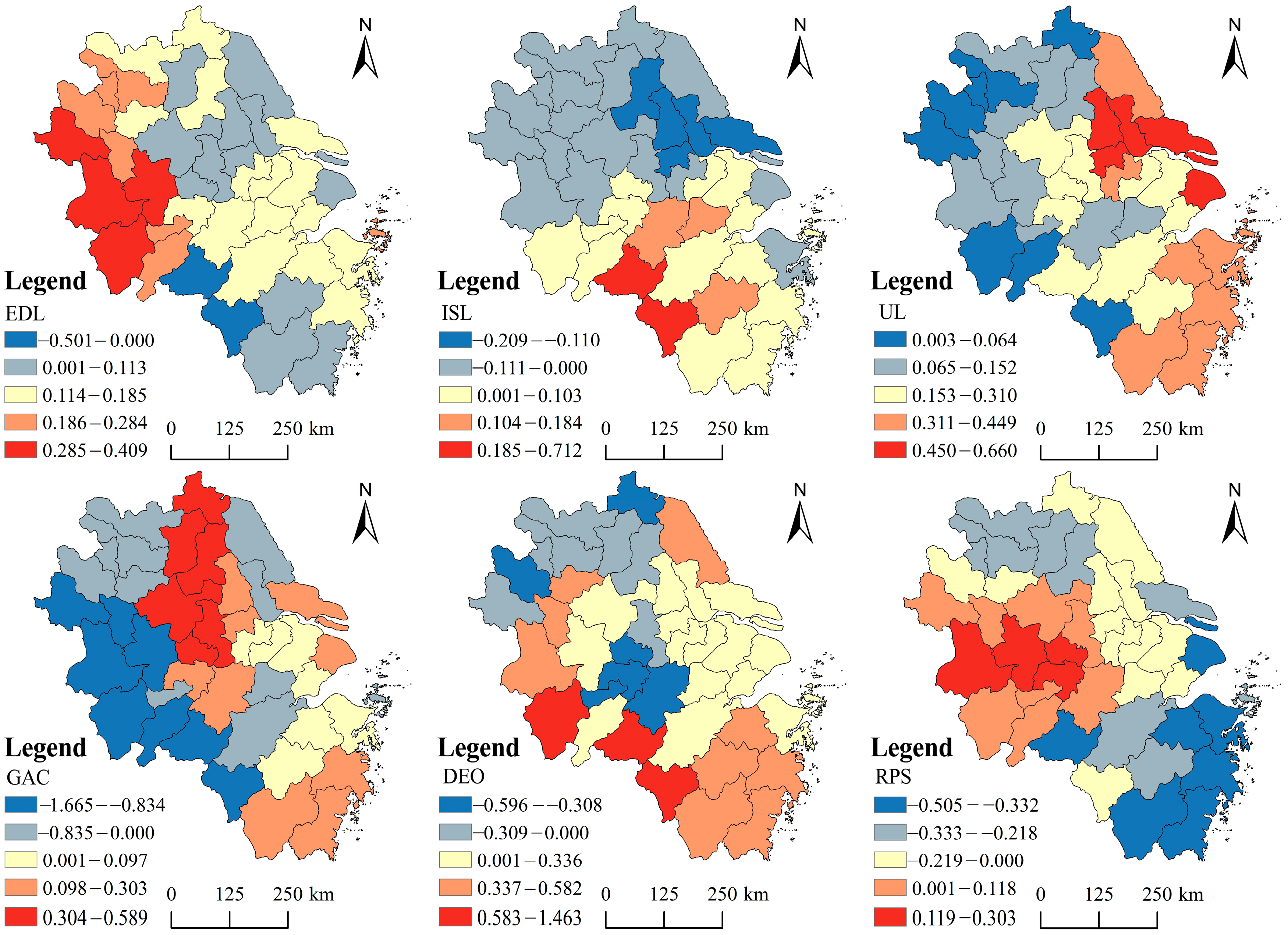
| Target Layer | Dimensional Layer | Indicator Layer | Weights |
|---|---|---|---|
| Basic Public Services | Basic Education Services | Financial expenditure on education per 10,000 people | 0.0351 |
| Number of general higher education schools per 10,000 people | 0.0603 | ||
| Number of general primary and secondary schools per 10,000 people | 0.0413 | ||
| Number of full-time teachers in primary and secondary schools per 10,000 people | 0.0143 | ||
| Medical and Health Services | Financial expenditure on medical care per 10,000 people | 0.0269 | |
| Number of hospitals per 10,000 people | 0.0273 | ||
| Number of hospital beds per 10,000 people | 0.0240 | ||
| Number of practicing (assistant) physicians per 10,000 people | 0.0248 | ||
| Social Security Services | Financial expenditure on social security per 10,000 people | 0.0447 | |
| Number of urban workers’ basic pension insurance participants per 10,000 people | 0.0468 | ||
| Number of urban workers’ basic medical insurance participants per 10,000 people | 0.0497 | ||
| Number of unemployment insurance participants per 10,000 people | 0.0542 | ||
| Public Cultural Services | Financial expenditure on culture and sports per 10,000 people | 0.0572 | |
| Number of public libraries per 10,000 people | 0.0463 | ||
| Public library book collections per 10,000 people | 0.0748 | ||
| Number of theaters and cinemas per 10,000 people | 0.0488 | ||
| Number of museums per 10,000 people | 0.0749 | ||
| Information and Communication Services | Number of Year-end fixed-line subscribers per 10,000 people | 0.0386 | |
| Number of Year-end cell phone subscribers per 10,000 people | 0.0368 | ||
| Number of Internet broadband access users per 10,000 people | 0.0401 | ||
| Number of post offices per 10,000 people | 0.0276 | ||
| Eco-environmental Services | Greening coverage rate of built-up areas | 0.0028 | |
| Comprehensive utilization rate of general industrial solid waste | 0.0027 | ||
| Centralized treatment rate of the sewage treatment plant | 0.0065 | ||
| Harmless treatment rate of domestic waste | 0.0047 | ||
| Infrastructure Services | Urban road area per capita | 0.0205 | |
| Number of buses per 10,000 people | 0.0281 | ||
| Length of drainage pipes per 10,000 people | 0.0340 | ||
| Urban water penetration rate | 0.0042 | ||
| Gas penetration rate | 0.0021 |
| City | 2010 | 2013 | 2016 | 2020 | City | 2010 | 2013 | 2016 | 2020 |
|---|---|---|---|---|---|---|---|---|---|
| Shanghai | 0.395 | 0.469 | 0.524 | 0.558 | Quzhou | 0.138 | 0.152 | 0.188 | 0.259 |
| Nanjing | 0.313 | 0.382 | 0.405 | 0.449 | Zhoushan | 0.268 | 0.317 | 0.387 | 0.461 |
| Wuxi | 0.290 | 0.359 | 0.389 | 0.447 | Taizhou | 0.150 | 0.174 | 0.208 | 0.251 |
| Xuzhou | 0.093 | 0.109 | 0.129 | 0.160 | Lishui | 0.179 | 0.213 | 0.237 | 0.285 |
| Changzhou | 0.237 | 0.257 | 0.293 | 0.345 | Hefei | 0.293 | 0.273 | 0.286 | 0.327 |
| Suzhou | 0.316 | 0.381 | 0.452 | 0.494 | Wuhu | 0.209 | 0.169 | 0.193 | 0.232 |
| Nantong | 0.101 | 0.172 | 0.198 | 0.237 | Bengbu | 0.153 | 0.156 | 0.162 | 0.197 |
| Lianyungang | 0.107 | 0.121 | 0.128 | 0.161 | Huainan | 0.151 | 0.158 | 0.147 | 0.165 |
| Huai’an | 0.092 | 0.112 | 0.132 | 0.161 | Ma’anshan | 0.246 | 0.182 | 0.198 | 0.245 |
| Yancheng | 0.100 | 0.107 | 0.132 | 0.167 | Huaibei | 0.169 | 0.171 | 0.186 | 0.217 |
| Yangzhou | 0.150 | 0.151 | 0.181 | 0.241 | Tongling | 0.223 | 0.307 | 0.206 | 0.230 |
| Zhenjiang | 0.211 | 0.241 | 0.291 | 0.335 | Anqing | 0.153 | 0.147 | 0.154 | 0.177 |
| Taizhou | 0.115 | 0.132 | 0.158 | 0.205 | Huangshan | 0.325 | 0.323 | 0.389 | 0.404 |
| Suqian | 0.119 | 0.130 | 0.147 | 0.174 | Chuzhou | 0.111 | 0.141 | 0.173 | 0.208 |
| Hangzhou | 0.364 | 0.401 | 0.449 | 0.492 | Fuyang | 0.111 | 0.103 | 0.084 | 0.109 |
| Ningbo | 0.301 | 0.360 | 0.398 | 0.435 | Suzhou | 0.092 | 0.085 | 0.089 | 0.119 |
| Wenzhou | 0.165 | 0.197 | 0.219 | 0.266 | Lu’an | 0.135 | 0.119 | 0.101 | 0.122 |
| Jiaxing | 0.247 | 0.299 | 0.320 | 0.388 | Bozhou | 0.116 | 0.109 | 0.103 | 0.122 |
| Huzhou | 0.183 | 0.226 | 0.279 | 0.368 | Chizhou | 0.173 | 0.178 | 0.193 | 0.216 |
| Shaoxing | 0.192 | 0.232 | 0.266 | 0.319 | Xuancheng | 0.123 | 0.141 | 0.164 | 0.202 |
| Jinhua | 0.190 | 0.228 | 0.261 | 0.317 | Average value | 0.190 | 0.212 | 0.234 | 0.275 |
| Year | Moran’s I | Z Score | p-Value |
|---|---|---|---|
| 2010 | 0.2967 | 3.3356 | 0.003 |
| 2011 | 0.3567 | 3.9674 | 0.002 |
| 2012 | 0.4004 | 4.3949 | 0.001 |
| 2013 | 0.4041 | 4.4423 | 0.001 |
| 2014 | 0.4302 | 4.5616 | 0.001 |
| 2015 | 0.4215 | 4.5773 | 0.001 |
| 2016 | 0.4743 | 5.1645 | 0.001 |
| 2017 | 0.4874 | 5.3130 | 0.001 |
| 2018 | 0.5168 | 5.6131 | 0.001 |
| 2019 | 0.5320 | 5.7596 | 0.001 |
| 2020 | 0.5562 | 5.9656 | 0.001 |
| OLS | TWR | GWR | GTWR | |
|---|---|---|---|---|
| R2 | 0.728 | 0.768 | 0.960 | 0.965 |
| Adjusted R2 | 0.725 | 0.765 | 0.960 | 0.964 |
| AICc | −1298.335 | −1337.640 | −2028.250 | −2033.480 |
| RSS | 1.439 | 1.231 | 0.212 | 0.186 |
| Bandwidth | - | 0.231 | 0.115 | 0.115 |
Publisher’s Note: MDPI stays neutral with regard to jurisdictional claims in published maps and institutional affiliations. |
© 2022 by the authors. Licensee MDPI, Basel, Switzerland. This article is an open access article distributed under the terms and conditions of the Creative Commons Attribution (CC BY) license (https://creativecommons.org/licenses/by/4.0/).
Share and Cite
Li, T.; Zhao, Y.; Kong, X. Spatio-Temporal Characteristics and Influencing Factors of Basic Public Service Levels in the Yangtze River Delta Region, China. Land 2022, 11, 1477. https://doi.org/10.3390/land11091477
Li T, Zhao Y, Kong X. Spatio-Temporal Characteristics and Influencing Factors of Basic Public Service Levels in the Yangtze River Delta Region, China. Land. 2022; 11(9):1477. https://doi.org/10.3390/land11091477
Chicago/Turabian StyleLi, Tianyu, Yizheng Zhao, and Xiang Kong. 2022. "Spatio-Temporal Characteristics and Influencing Factors of Basic Public Service Levels in the Yangtze River Delta Region, China" Land 11, no. 9: 1477. https://doi.org/10.3390/land11091477
APA StyleLi, T., Zhao, Y., & Kong, X. (2022). Spatio-Temporal Characteristics and Influencing Factors of Basic Public Service Levels in the Yangtze River Delta Region, China. Land, 11(9), 1477. https://doi.org/10.3390/land11091477





